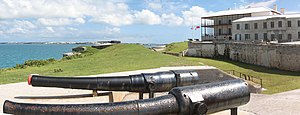| Royal Naval Dockyard, Bermuda | |
|---|---|
| Bermuda
| |
 6-inch guns overlook the Great Sound | |
| Type | Shipyard, dockyard, HMD |
| Site information | |
| Operator | Royal Navy |
| Controlled by | Navy Board (1795–1832) Board of Admiralty (1832–1951) Board of Admiralty (1951–1964) and Navy Board (1964–1982) and Government of Bermuda 1951–1982 Navy Board and West End Development Corporation 1982–1995 |
| Site history | |
| Built | 1795 |
| In use | 1795–1995 |
| Battles/wars | American War of 1812 First World War Second World War Cold War |
| Garrison information | |
| Past commanders | Resident Commissioner Bermuda (1816-1832) Admiral Superintendent Bermuda (1832-1938) Commodore-in-Charge, Bermuda (1938-1946) Commodore West Indies and Senior Naval Officer (1956-1976) |
| Occupants | North America Squadron |
 |
| His Majesty's Naval Service of the British Armed Forces |
|---|
| Components |
|
| History and future |
| Operations |
| Equipment |
| Personnel |
| Auxiliary services |
HMD Bermuda (Her/His Majesty's Dockyard, Bermuda) was the principal base of the Royal Navy in the Western Atlantic between American independence and the Cold War. The Imperial fortress colony of Bermuda had occupied a useful position astride the homeward leg taken by many European vessels from the New World since before its settlement by England in 1609. French privateers may have used the islands as a staging place for operations against Spanish galleons in the 16th century. Bermudian privateers certainly played a role in many English and British wars following settlement, with its utility as a base for his privateers leading to the Earl of Warwick, the namesake of Warwick Parish, becoming the most important investor of the Somers Isles Company. Despite this, it was not until the loss of bases on most of the North American Atlantic seaboard (following US independence) threatened Britain's supremacy in the Western Atlantic that the island assumed great importance as a naval base (the attendant Bermuda Garrison of the British Army existed primarily to protect the naval base). In 1818 the Royal Naval Dockyard, Bermuda officially replaced the Royal Naval Dockyard, Halifax, as the British headquarters for the North America Station (which would become the North America and West Indies Station after absorbing the Jamaica Station in 1830 (and would ultimately be designated the America and West Indies Station after the First World War, once it absorbed the areas that had formerly belonged to the South East Coast of America Station and the Pacific Station).
As prior to 1959, under section 87 of the Naval Discipline Act 1866 (29 & 30 Vict. c. 109),[1] only sailors on the books of a commissioned naval vessel were subject to naval discipline, naval personnel assigned to shore duties were listed administratively as crew members of depot ships, originally usually hulks of old warships. In Bermuda, the depot ship was HMS Terror from 1857 to 1897, which was replaced by the former troopship HMS Malabar (renamed HMS Terror in 1901). The former HMS Malabar was sold in 1918, following which the name HMS Malabar was applied to the Casemates Naval Barracks in the dockyard as a stone frigate under command of the Captain in Charge to which the shore personnel at Bermuda, whether belonging to the dockyard, to outlying naval facilities (such as Admiralty House, Bermuda, Royal Naval Air Station Bermuda, or the Royal Naval wireless station (from 1961, NRS Bermuda) at Daniel's Head), or to minor vessels assigned to the dockyard for local use, were administratively assigned. As a consequence, HMS Malabar was often used interchangeably with HM Dockyard Bermuda or Royal Naval Dockyard Bermuda, and has been often mistaken as referring only to specific subordinate naval facilities in Bermuda, such as the wireless station at Daniel's Head or the Royal Naval Air Station. After the Bermuda dockyard was reduced to a base in the 1950s, the part that continued to operate as a naval base was commissioned as HMS Malabar until 1995.